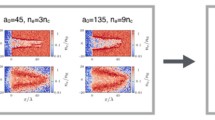Abstract
We consider the results of computational experiments concerning the expansion of a plasma generated by laser radiation at the stage of a nanosecond prepulse ahead of the main femtosecond-range pulse. A series of plasmodynamic calculations are performed for various laser target materials. It is shown that in the considered problem statement, which corresponds to the typical conditions of full-scale experiments, the distribution of the laser plasma density as a whole is satisfactorily approximated by a simple three-parameter formula.




Similar content being viewed by others
RЕFERENCES
D. Strickland and G. Mourou, “Compression of amplified chirped optical pulses,” Opt. Commun. 56 (3), 219–221 (1985). https://doi.org/10.1016/0030-4018(85)90120-8
T. Esirkepov, M. Borghesi, S. V. Bulanov, G. Mourou, and T. Tajima, “Highly efficient relativistic-ion generation in the laser-piston regime,” Phys. Rev. Lett. 92 (17), 175003 (2004). https://doi.org/10.1103/PhysRevLett.92.175003
P. Hadjisolomou, I. P. Tsygvintsev, P. Sasorov, V. Gasilov, G. Korn, and S. V. Bulanov, “Preplasma effects on laser ion generation from thin foil targets,” Phys. Plasmas 27 (1), 013107 (2020). https://doi.org/10.1063/1.5124457
C. S. Liu, V. K. Tripathi, and B. Eliasson, High-Power Laser-Plasma Interaction (Cambridge University Press, Cambridge, 2019). https://doi.org/10.1017/9781108635844
D. A. Tidman and R. A. Shanny, “Field-generating thermal instability in laser-heated plasmas,” Phys. Fluids 17 (6), 1207–1210 (1974). https://doi.org/10.1063/1.1694866
D. A. Tidman, “Strong magnetic fields produced by composition discontinuities in laser-produced plasmas,” Phys. Rev. Lett. 32 (21), 1179–1181 (1974). https://doi.org/10.1103/PhysRevLett.32.1179
A. Yu. Krukovskiy, V. G. Novikov, and I. P. Tsygvintsev, “3D simulation of the impact made by a noncentral laser pulse on a spherical tin target,” Math. Models Comput. Simul. 9 (1), 48–59 (2017). https://doi.org/10.1134/S2070048217010082
S. Faik, A. Tauschwitz, and I. Iosilevskiy, “The equation of state package FEOS for high energy density matter,” Comput. Phys. Commun. 227, 117–125 (2018). https://doi.org/10.1016/j.cpc.2018.01.008
A. J. Kemp and J. Meyer-ter-Vehn, “An equation of state code for hot dense matter, based on the QEOS description,” Nucl. Instrum. Methods Phys. Res., Sect. A 415 (3), 674–676 (1998). https://doi.org/10.1016/S0168-9002(98)00446-X
A. F. Nikiforov, V. G. Novikov, and V. B. Uvarov, Quantum-Statistical Models of Hot Dense Matter: Methods for Computation Opacity and Equation of State (Birkhäuser, Basel, 2005). https://doi.org/10.1007/b137687
M. Born and E. Wolf, Principles of Optics, 6th ed. (Pergamon, Press, 1980).
T. B. Kaiser, “Laser ray tracing and power deposition on an unstructured three-dimensional grid,” Phys. Rev. E 61 (1), 895–905 (2000). https://doi.org/10.1103/PhysRevE.61.895
M. M. Basko and I. P. Tsygvintsev, “A hybrid model of laser energy deposition for multi-dimensional simulations of plasmas and metals,” Comput. Phys. Commun. 214, 59–70 (2017). https://doi.org/10.1016/j.cpc.2017.01.010
I. P. Tsygvintsev, A. Yu. Krukovskiy, V. A. Gasilov, V. G. Novikov, and I. V. Popov, “Mesh-ray model and method for calculating the laser radiation absorption,” Math. Models Comput. Simul. 8 (4), 382–390 (2016). https://doi.org/10.1134/S2070048216040153
I. V. Romanov, I. P. Tsygvintsev, V. L. Paperny, A. A. Kologrivov, Yu. V. Korobkin, A. Yu. Krukovskiy, and A. A. Rupasov, “Influence of the laser plasma-expansion specific on a cathode jet formation and the current stability in a laser-ignited vacuum discharge,” Phys. Plasmas 25 (8), 083107 (2018). https://doi.org/10.1063/1.5037001
Funding
This study was carried out using the equipment of the Center for Collective Use of Keldysh Institute of Applied Mathematics, Russian Academy of Sciences (supercomputers K-60 and K-100).
Author information
Authors and Affiliations
Corresponding author
Ethics declarations
The authors declare that they have no conflicts of interest.
Rights and permissions
About this article
Cite this article
Tsygvintsev, I.P., Gasilov, V.A. On the Density Distribution of a Plasma Generated by a Femtosecond Laser Prepulse. Math Models Comput Simul 15, 623–629 (2023). https://doi.org/10.1134/S2070048223040191
Received:
Revised:
Accepted:
Published:
Issue Date:
DOI: https://doi.org/10.1134/S2070048223040191




